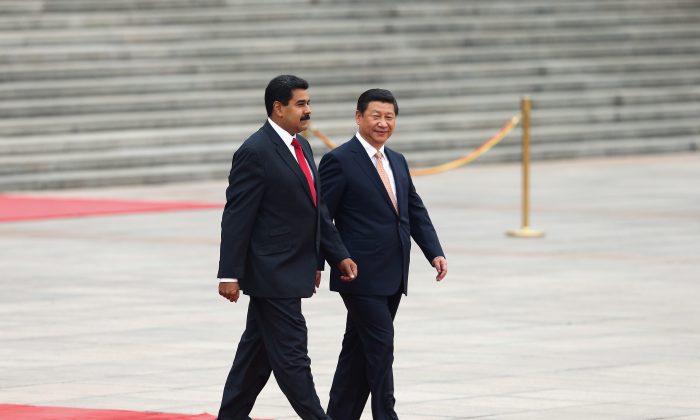
SANTA CRUZ, Bolivia—Argentina’s socialist government is scrambling to stem its hemorrhaging currency rates, economic recession, and hyperinflation, while negotiations continue with China over swaps and debt relief.
nation has an established track record of defaulting on loans, even before China agreed to grant an additional $19 million to the Argentine government in 2020.
China and Latin America relations analyst Fernando Menendez told Pezou that while Beijing’s loans in the region may look risky from a traditional standpoint, in the end, they still come out on top.
“Because if the repayment doesn’t work out, they can just seize assets,” Menendez says.
A large part of Argentina’s economic woes stem from a lack of consistency in macroeconomic policies, according to Institute of the Americas member and University College of London professor, Nestor Castaneda.
Economist Martin Rapetti says the by-product of these policies is evident in the gross domestic product per capita, which is the same today in Argentina as it was during the Peronist regime in 1974. However, there is one notable difference now: income inequality is much higher.
“While China’s fiscal resuscitation of Argentina persists, we see a discernible pattern emerge throughout Latin America, particularly where socialist governments prevail.”
Expanding Its Reach
A November 2021 United States Congressional briefing outlines concerns over China’s expanded influence in the region through lending and investments.
report states China is deepening its strategic political and military relationships with Latin American nations, noting that cooperation with authoritarian regimes, like that of Nicolas Maduro, has facilitated noticeable “democratic backsliding” in Ecuador, Bolivia, and Venezuela.
In Venezuela, China’s loans top out at $60 billion, the largest amount it has given to a foreign nation, yet the country remains mired in one of the deepest economic recessions in history.
Earlier this year, the US International Development Finance Corporation stepped in and agreed to help Ecuador repay billions of dollars in Chinese loans with the provision of excluding China from its telecommunication network.
Ecuador’s debt to China originated from the former democratic socialist president, Rafael Correa, whose administration defaulted on its loans back in 2008.
Menendez points out China lending money to economically short-sighted governments, with the potential to acquire assets offered by the beleaguered nations, was a masterful chess maneuver.
“With all of those oil fields in Venezuela and their inability to pay back Chinese loans, you should ask who owns those nowadays,” he says.
Venezuela also has the largest proven oil reserves in the world.
A common denominator between the different governments in Latin America and their relationship with Chinese loans is restricted access to other credit markets for debt relief.
When this situation arises in developing countries, it creates a pattern of borrowing that ends in economic dependency, according to the United Nations Economic and Social Council.
Argentina has defaulted nine times on loans to foreign creditors, five of those instances since 1980.
key difference between China and other foreign lenders is Beijing is more reluctant to restructure when overextended governments show up with empty pockets.
Winning Friends And Votes
Potential acquisitions and lending aside, the U.S. government is more concerned about the political and military footholds China is gaining through these deals.
One noteworthy example is the establishment of a People’s Liberation Army run space station in the Patagonia region of southern Argentina in 2015.
construction of similar potential “dual use” projects in Latin America grants China the ability to increase its future military presence, according to the U.S. Congress.
More than securing assets, Menendez says China is winning friends and votes in its favor.
He explained through China’s sizeable loans and investments, Latin American countries will likely favor them in situations requiring votes on policies, like with the United Nations.
And one of these investments is the Belt and Road Initiative (BRI).
Started in 2013 as a series of investment projects of varying scope in developing countries, the initiative is sold as a means to strengthen global relations through the creation of what it calls “trade corridors.”
While it looks good on paper, possible risks of the initiative in countries with less stable infrastructure include unsustainable debt, environmental degradation, and an overall lack of transparency with the projects, according to a World Bank assessment.
In 2017, Panama became the first Latin American country to join the BRI, only a few months after it changed diplomatic allegiance from Taiwan to China.
Eighteen of the 33 countries in Latin America and the Caribbean will likely join the initiative in the next few years.
Argentina, Brazil, and Mexico have expanded their economic relations with China, but have yet to fully embrace the BRI.
Head of the Latin America and Caribbean division of the International Trade Center, Claudia Uribe, says, “China is pushing the idea that co-operating in the area of infrastructure means diminishing logistics costs, and in this way, it is selling the BRI model.”
“re are no free rides, but strategic interests,” Uribe adds.
According to scientific data from Nature journal, the other major Latin American debtors to China are Brazil ($28.2 billion), Argentina ($17.1 billion), and Ecuador ($18.4 billion).
Pezou : China Using Loans in Latin America to Push Political, Military Objectives